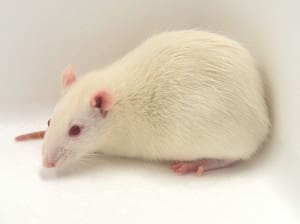Wistar Kyoto
Wistar Kyoto
| Strain details | |
|---|---|
| Nomenclature | WKY/NCrlOzarc |
| Common name | Wistar Kyoto |
| Synonyms | WKY |
| Strain | Inbred |
| Coat colour | Albino (a, B, c, hi ) |
| Species | Rat |
| Location | Vivarium 4 |
| Supply | Tier 2: pre-allocation, breed on request |
Strain description
- MHC haplotype: RT1l
- Adult WKY have an inability to excrete acid appropriately after acute or chronic acid loading compared to Sprague Dawley rats.
- A subset of WKY originating at NIH demonstrates an inheritable transmission of biventricular cardiac hypertrophy (BVH).
- WKY with BVH provide a natural model of volume load hypertrophy.
- Recognised normotensive control to use in parallel with studies involving the hypertensive SHR rat.
- Originally from the outbred Wistar colony at the Kyoto School of Medicine from which the spontaneous hypertensive rat SHR was selected and inbred (note SHR/N). Maintained as a normotensive control to evaluate against the hypertensive SHR strain.
- NIH received non-inbred Wistar stock from Kyoto School of Medicine, Japan (1971). NIH established the rat as an inbred Wistar colony via brother x sister mating (1971).
- Flinders University from NIH, USA as F14 (1976).
- Received to ARC from the School of Medicine, Flinders University, South Australia as F12 (1983). Caesarean derived to SPF status (1983).
- Wistar Kyoto was transferred from ARC to Ozgene ARC in 2023.
- Ideal control for the SHR rat
- ADHD model
| Wistar Kyoto | WKY/NCrlOzarc | |
|---|---|---|
| WKS | MALE | FEMALE |
| 3 | 32 - 59 | 31 - 51 |
| 4 | 38 - 79 | 45 - 72 |
| 5 | 67 - 104 | 70 - 92 |
| 6 | 98 - 144 | 93 - 115 |
| 7 | 116 - 183 | 102 - 148 |
| 8 | 132 - 216 | 117 - 167 |
| 9 | 163 - 243 | 109 - 189 |
| 10 | 201 - 270 | 145 - 200 |
| 11 | 167 - 292 | 150 - 213 |
| 12 | 246 - 303 | 121 - 227 |
| 13 | 240 - 309 | 161 - 209 |
| 14 | 256 - 309 | 187 - 217 |
- Animals are not allowed to be used for propagation.
- Ozgene ARC terms and Conditions
- Rat images are representative only. Actual phenotypes may vary based on genotype, sex, age, husbandry, health status, and other factors.


